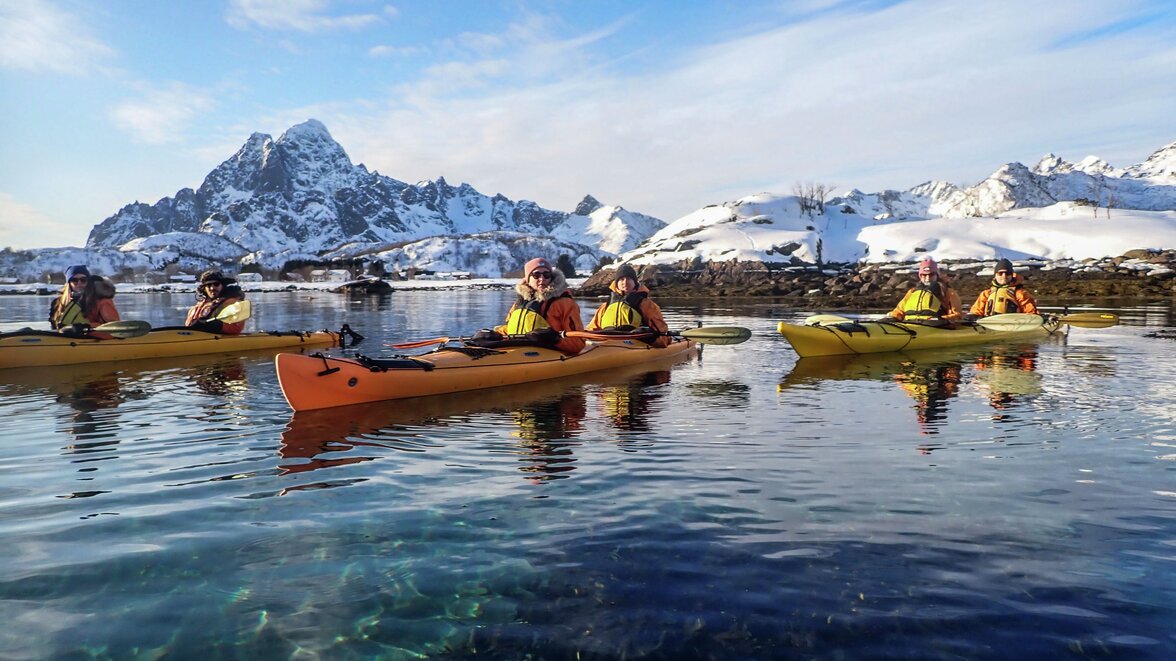Kayaking in Lofoten
Did you know that Lofoten is a kayaking paradise? Here, you are assured of a quiet and peaceful nature-based experience – all year round.
For experienced paddlers, few experiences compare to watching the sunset from a kayak. The locals of Lofoten know that the ocean surrounding their islands offers some of the most breathtaking skies. Combining these two facts gives you the perfect reason to plan your next kayaking holiday in the fjords of Lofoten.
Trying kayaking for the first time?
Lofoten is one of the most beautiful places in Norway for kayaking.
With its many islets, turquoise seas and shallow water, this wonderful archipelago is also a perfect place for beginners. If you don’t have a Wet Card, you can’t rent a kayak and head out on your own.
We encourage trips with experienced guides, so you will feel completely safe and get most out of the experience. If you can paddle and have a Wet Card, you can also contact various activity providers to rent a kayak.
Kayaking in the Midnight Sun
Many consider kayaking a summer activity, which is completely understandable. The water is often a bit warmer in the summer months and it’s generally lighter.
Many believe that the light is a factor that makes Lofoten so unique – and the light that can seem different every day throughout the year. From late May to mid-July, when the Midnight Sun shines, it’s light in Lofoten around the clock.
You can read more here about the Midnight Sun in Lofoten and find out which places we recommend you experience it from.
Several activity providers offer various organised kayaking trips in the Midnight Sun – adapted suit everyone from beginners to experienced kayakers.
Kayaking in the winter
There is infinitely more to the year than summer – and light so infinitely more than sunlight.
From late August to mid-April, it’s possible to see the Northern Lights in Lofoten. As Lofoten is situated under the Northern Lights Oval, it’s possible to see the Northern Lights in all directions, which you can read more about in this article.
This natural phenomenon forms a unique setting for a rather spectacular paddling experience. The water and the world are completely calm as the mythical Northern Lights carpet bomb the sky with colours.
Some activity providers offer Northern Lights kayaking – adapted suit everyone from beginners to experienced kayakers. If you wish to have a truly unique Northern Lights experience, just pack your super underwear – and remember your camera.
Best spots for paddling?
If you manage to get out and feel the splash of the waves and the sea wind against the boat and your face, you will probably agree that most places around Lofoten are a bit nicer from a kayak. Nevertheless, we have tried to pick out the areas we like best:
- Reine: Reinefjorden is surrounded by high mountains and is therefore sheltered from much of the weather and wind. In Reine, you can join a kayak tour with Reine Paddling or Reine Rorbuer if you don’t have prior experience. You can paddle all the way to Kjerkfjorden or Vindstad, which is the starting point for a hike to the hidden gem Bunessanden. Find kayaking providers in Reine here.
- Ballstad: Ballstad is shielded from the sea by many small islands. No matter where you look, the iconic Skottind will capture much of your attention. In Ballstad, you can join Lofoten Diving on a kayak tour in beautiful nature. They also offer other year-round water-based experiences, such as snorkeling and diving, which can be combined. Find kayaking providers in Ballstad here.
- Eggum: The small fishing village of Eggum is located on the outer side of Lofoten, making it a perfect place to kayak in the midnight sun or under the northern lights. The archipelago at Eggum has several islets and skerries suitable for both experienced and novice kayakers. At Eggum, you will find Northern Explorer, which offers various guided kayak tours.
- Sandvika and Ørsvågvær: The archipelago outside Kabelvåg offers many possibilities depending on how far you want to paddle. There are several islets, coves, and beaches to explore. Lofoten Aktiv and XXLofoten offer guided tours in the area, suitable for both experienced paddlers and families with children. Find kayaking providers in the area here.
- Svolvær: The harbor in Svolvær is a perfect place for beginners in kayaking. Here you paddle between fishing boats, through narrow straits, and in the archipelago just outside the town. XXLofoten takes you on summer and winter tours in Svolvær. If you want a full-day tour, Lofoten Aktiv will pick you up here and take you to the beautiful Trollfjorden. Trollfjorden is a small and narrow fjord arm in Raftsundet, surrounded by some of the highest mountains in the area. Find kayaking providers in the area here.
- Skrova: The small island of Skrova is located out in the open sea, surrounded by several small islands and skerries with beautiful beaches and clear water. Here you can join Skrova Kayak Adventures to paddle in the archipelago and experience the midnight sun.
Always think about safety
Safety is always important, especially when heading out to sea in a small boat like a kayak. Consequently, it’s an obvious requirement that everyone who paddles in Lofoten follows the Norwegian Maritime Authority’s padlevettreglene.
If you are an experienced paddler and have a Wet Card, you have the option of renting a kayak and other gear and plan your trip. However, if you don’t have previous kayaking experience, an organised kayaking trip will suit you better.
Paddling safety guidelines
- Choose a boat that suits your skills and the trip.
- Check that the equipment is in order.
- Dress according to the water temperature. Bring extra clothing.
- Always wear an approved paddling vest.
- Do not overestimate your own abilities. Practice rescue techniques.
- If you capsize, do not leave the boat or paddle.
- Respect the weather and wind, and check the weather forecast before going out in a kayak or canoe.
- Keep a good distance from other boats. Make sure you are seen.
- Learn lifesaving techniques.
- Be environmentally conscious. Show consideration for nature. Remember to leave no trace.
Source: Sjørfartsdirektoratet


